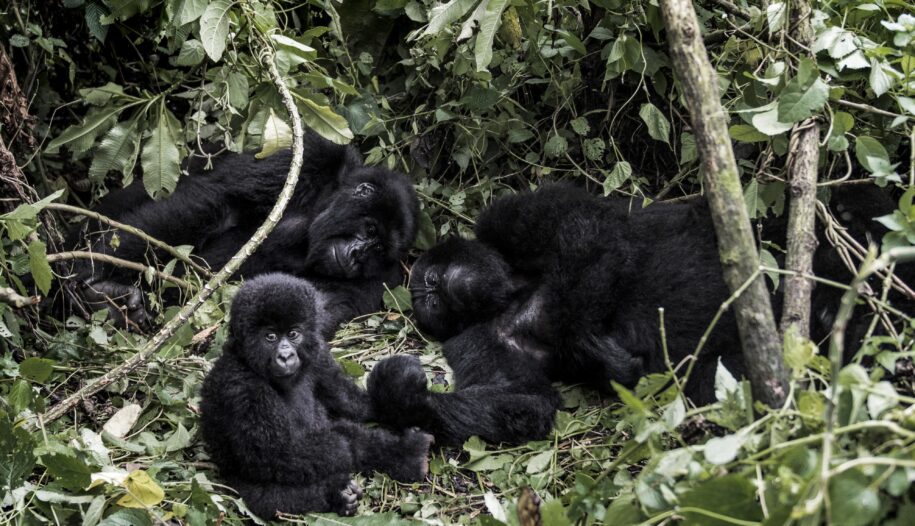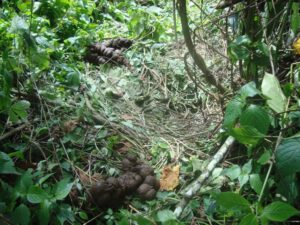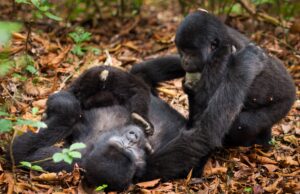Gorilla nesting refers to the behaviour of great apes constructing sleeping platforms using vegetation. In Rwanda’s Volcanoes National Park, this daily habit shapes how conservation professionals understand gorilla behaviour, movement, and welfare.
Mountain gorillas build a new nest every evening, selecting specific locations and materials based on weather, safety, and group dynamics. This practice, though routine, offers crucial insight into their cognitive patterns and adaptability.
For wildlife specialists and conservation-focused guides, nesting behaviour is not a minor observation. It is a key indicator of gorilla health, habitat use, and social structure.
Field researchers, trackers, and eco-guides rely on nest sites to monitor population distribution, determine group cohesion, and track individual gorillas. In low-impact tourism models, these signs help direct excursions while minimising disturbance.
Understanding gorilla nesting improves both conservation strategy and visitor education. It turns observation into interpretation. It brings depth to what might otherwise be a passing sight.
What Is Gorilla Nesting?
Gorilla nesting refers to the daily construction of sleeping platforms made from surrounding vegetation. Each gorilla builds a new nest every night before sleep.
They use branches, leaves, and flexible stems to create a stable surface for resting. Nest-building typically starts in the late afternoon, once feeding ends.
This behaviour is consistent across age groups, except for very young infants, who sleep with their mothers. Juveniles begin building their nests by age three.
Most nests are built on the ground, though arboreal nests are also common in areas with lower predation risk or abundant trees.
Nesting serves multiple functions: it insulates the body from the cold, protects against parasites, and signals individual and group presence through physical traces.
The decision on where and how to build is shaped by weather, safety, and group movement. Nests also mark resting locations, helping researchers study population dynamics and ranging behaviour.
Each nest exists for one night only. Gorillas abandon them by morning, leaving behind a temporary but informative footprint on the forest floor.
How Gorillas Build Their Nests
Nest-building begins shortly after the group finishes its late-afternoon feeding session. Adults initiate the process by scanning the immediate area for suitable construction sites.
Site selection depends on factors such as ground moisture, canopy cover, wind exposure, and the presence of thorny or irritating plants. Gorillas avoid disturbed or unstable ground.
Once the location is chosen, the individual gathers nearby vegetation, selecting pliable but strong materials. Common plants include bamboo, wild celery, and other broad-leafed herbs.
The gorilla bends larger stems inward to form a rough circular frame. Then, it weaves in smaller twigs, grasses, and soft leaves to create a padded surface.
Adults use both hands and feet with precision, gripping stems and folding them methodically. Nest construction requires balance, strength, and dexterity.
For ground nests, the structure lies slightly raised, insulated from damp soil by layers of plant material. The final product has defined edges and a concave centre.
Tree nests follow a similar method but require more support. The builder selects a wide horizontal branch, then weaves multiple stems across it to form a stable base.
In arboreal nests, leaf layering is denser to prevent slipping and improve comfort. Juvenile gorillas are more likely to nest in trees due to their lighter body weight.
Infants under three years old do not build nests. They sleep alongside their mothers in shared sleeping spaces within the maternal nest.
Each nest takes between 10 and 25 minutes to complete, depending on the gorilla’s age, experience, and available materials. Nest construction is silent, focused, and deliberate.
By morning, the group leaves the nest site. These abandoned structures provide researchers with measurable data points, including group size, composition, and recent movement direction.
Social and Survival Functions of Gorilla Nesting
1. Physical Protection and Parasite Avoidance
Nests provide a physical barrier between the gorilla’s body and the forest floor. By layering leaves and stems, gorillas reduce contact with damp soil, thorns, or sharp debris.
This structure limits the risk of skin abrasions, fungal infections, and insect bites. Some plant species used in nesting contain natural insect-repelling compounds, which help reduce exposure to ectoparasites.
In regions with dense undergrowth, gorillas often clear the area around the nest to remove irritants or potential threats such as ants or sharp-edged grasses.
2. Thermoregulation and Environmental Insulation
Nesting helps gorillas conserve body heat during cold nights, particularly at high elevations where temperatures can fall below 10°C after sunset.
The layered vegetation acts as insulation, trapping body heat within the nest. This is especially critical for juveniles and older individuals with less efficient thermoregulation.
In rainy conditions, gorillas choose nest sites under thick canopy cover or natural windbreaks. This reduces exposure to moisture and prevents rapid heat loss during sleep.
Arboreal nests, when used, are more common during dry periods and in younger individuals who tolerate cooler conditions more easily.
3. Infant Development and Maternal Care
Infants under three years sleep exclusively in their mother’s nest. This provides warmth, protection, and uninterrupted contact throughout the night.
The maternal nest becomes a space for bonding and learning. Infants observe construction behaviour nightly, gaining early exposure to technique and spatial awareness.
As they grow, juveniles begin building small, separate nests nearby. This gradual transition encourages independence while maintaining safety within the group’s nesting range.
Maternal care at night also includes physical contact, vocal reassurance, and repositioning the infant if it becomes too cold or restless.
4. Group Cohesion and Social Structure
Nest positioning offers insight into group relationships. Gorillas typically nest within visible range of one another, maintaining individual space while staying within the protective range of the dominant male.
Silverbacks often choose locations that give them a clear view of the group’s outer perimeter. This serves a protective role and reinforces their leadership position.
Nest clusters reflect emotional and social dynamics. In calm, cohesive groups, individuals sleep closer together. In groups recovering from internal conflict or external threat, spacing may widen noticeably.
Spatial patterns in nest layout help researchers assess social stability, rank dynamics, and signs of stress without direct interference.
5. Scent-Marking and Communication
Each gorilla leaves a distinct scent in its nest through natural skin secretions. These olfactory markers help identify recent occupancy and reinforce group identity.
Scent trails aid in-group cohesion and serve as passive signals to other gorilla groups, which may avoid recently used nesting zones.
Researchers can use these scent-marked nests to estimate how long a group has been in a particular area, improving tracking accuracy during long-term monitoring.
Gorilla Nesting in Rwanda’s Volcanoes National Park
Volcanoes National Park spans approximately 160 square kilometres along Rwanda’s northwestern border. It forms part of the transboundary Virunga Massif, home to several habituated gorilla groups.
The park’s montane and bamboo forests offer abundant nesting material and consistent shelter. Altitude variation creates microclimates that influence where gorillas choose to build.
Gorillas typically select nesting sites within mid-elevation zones, between 2,500 and 3,200 meters. These areas provide a balance of vegetation density, feeding resources, and temperature regulation.
Rwanda’s protected status and strong anti-poaching enforcement contribute directly to the stability of gorilla nesting behaviour. Uninterrupted routines allow for consistent observation and documentation.
Conservation teams record nest sites daily during tracking missions. These records help confirm group location, determine movement patterns, and verify population counts.
Trackers use fresh nests from the previous night to begin locating gorilla families in the morning. The number, type, and condition of nests guide route planning.
Nest construction varies slightly between groups, depending on feeding range and vegetation access. Over time, trackers recognise individual nesting styles, especially among silverbacks and long-observed females.
Eco-guides incorporate nest interpretation into the guided visit, explaining details such as vegetation type, nest shape, and group spacing to contextualise the observation.
Rwanda’s permit-controlled gorilla trekking system limits human presence and protects nesting areas from trampling or contamination. This approach preserves both the physical sites and the behavioural integrity.
What Gorilla Nesting Tell Us
Every abandoned nest provides measurable data. Field teams document their location, size, structure, and materials as part of daily monitoring protocols.
Nest counts allow researchers to estimate group size. Each adult and juvenile builds one nest, while infants share with their mothers.
By mapping nest sites over time, conservationists can identify feeding zones, seasonal shifts, and preferred altitudes. These patterns help inform habitat protection strategies.
The type of vegetation used reveals what plants gorillas depend on. It also reflects foraging behaviour and resource availability in different sections of the park.
Health indicators often emerge from close nest inspection. The presence of parasites, faecal samples, or signs of injury can signal medical concerns within the group.
Social dynamics also leave physical clues. Nest placement can indicate hierarchy, with dominant silverbacks nesting slightly apart or at key defensive positions.
Changes in nest-building behaviour can suggest environmental pressure. For example, an increase in arboreal nesting may reflect damp ground conditions or insect presence.
Consistent monitoring builds long-term datasets. These records support population viability studies, inform transboundary conservation policy, and strengthen international wildlife reporting.
Researchers often revisit historical nesting areas to compare data year-over-year. This contributes to understanding how gorillas adapt to ecological changes, including climate variability and human activity nearby.
Conclusion
Gorilla nesting demonstrates environmental mastery, social structure, and habitual intelligence. It reflects how gorillas interpret space, manage safety, and maintain group cohesion.
Each nest records an active decision: where to stop, how to build, and who to rest near. These choices reveal long-standing behavioural patterns shaped by climate, ecology, and memory.
Nesting anchors field research and conservation management. It offers a stable, visible behaviour that links daily movement to long-term survival.
This practice defines rhythm, territory use, and intergenerational learning. It holds measurable value for science and irreplaceable meaning in the life of the species.



